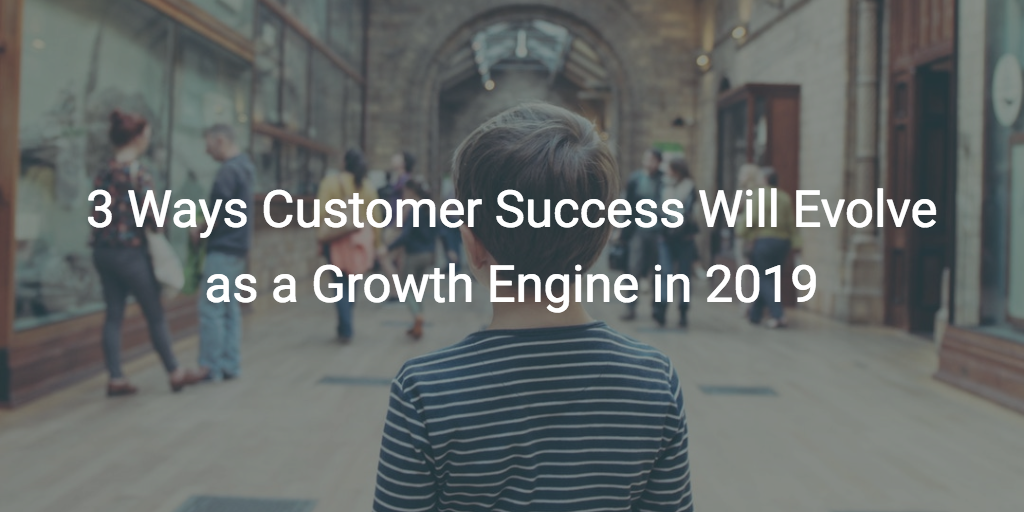“Customer Success Management is hitting the mainstream.”
That’s what Forrester analyst TJ Keitt said in his September 2018 report, How to Build a Customer Success Program, and I couldn’t agree more. He goes on to validate it by citing the 44,000 Customer Success Manager (CSM) roles posted on LinkedIn (a 560% increase year-over-year in the number of postings!) along with Gainsight’s own rapidly-growing Pulse conference as proof points.
If you’re a long-time CS booster, you might be saying to yourself, “Duh!” But there’s a great big world out there, and most people in it haven’t even heard of Customer Success—but that’s changing fast.
When we look back, we may come to view 2018 as a seminal moment for Customer Success. And if 2018 is the year CSM “hit the mainstream” as TJ Keitt put it, 2019 will be the year it became indispensable for business.
Next year, we’ll see more and more digital business leaders double down on delivering customer outcomes. They’re realizing it’s the most foundational step to building a revenue advantage. Customer Success will continue to blossom beyond glorified support and relationship management to become a full-fledged, scalable growth engine.
If you’re in an organization currently undergoing this transformation or fighting to ignite it, here are three trends in Customer Success to look out for—and implement at your company—in 2019.
1. Technology: Expanding Digital Services
With SaaS as the dominant software delivery model these days, helping customers realize value is increasingly taking place through digital means. Today’s customer expects to conveniently and inexpensively address many business challenges without having to interact with anyone. Upping the ante on digital services gives an edge in two important ways:
- Customers are happier when their needs are anticipated and addressed through efficient digital means.
- This mode of delivery is the textbook definition of scalable.
2019 is the year to start scaling Customer Success. Leverage technologies that sequence human actions and trigger digital touches in tandem to improve customer outcomes based on signals like customer health. This gives a proven lift to Custom Success-driven growth, and I’ll point to Keitt’s report referenced above for you to learn more if this sounds like you.
For SaaS organizations that have already embarked on this path, 2019 is the year to enhance your Customer Success delivery with technology to understand product adoption as part of a bigger picture, and leverage the product as a channel to automate onboarding, adoption, and expansion programs. Master that and you’ll have a powerful toolkit to reduce churn and boost net revenue retention.
2. Processes: Aligning to Achieve
Speaking of growth KPIs, another area of focus is alignment. Specifically, alignment on the mission of your Customer Success organization and what your mission means at a KPI-level (one that ideally connects leading indicators to the lagging indicators of pure revenue performance). In other words, without organizational buy-in around a metrics-driven mandate to drive growth in the Customer Success charter, the function will struggle to perform as a growth engine.
This might seem like an obvious statement, but we see it as an area with tremendous potential for improvement in lots of companies we work with. As TSIA says in their latest State of Customer Success report, “If your organization does not have clear delineation on adoption, retention, and expansion capabilities between sales, marketing, services, and other cross-functional teams, you will not be successful.” The good news is there are myriad success stories on this front. In 2019, expect the trailblazers who’ve stood up Customer Success as a growth engine to continue to illuminate the science of process and KPI alignment.
3. People: Building Growth Teams
Much has been made about staffing challenges in Customer Success. Demands placed on digital businesses to deliver outcomes have turned it into one of the fastest growing professions. In addition to the LinkedIn data cited previously, TSIA noted a 29% increase in compensation for CSMs as proof of the demand for (and shortage of) qualified professionals.
But compounding this challenge may be the shifting expectation for Customer Success to serve as a growth function. In fact, Customer Success in many organizations is evolving into what TSIA calls customer growth teams, which include “comprehensive post-sales functions.” This directly influences the profiles, compensation, and staffing levels of the CSM organization. Rest assured, 2019 will include plenty of research to clarify best practices on building a growth-oriented Customer Success team—from compensation to capabilities.
***
With so much of today’s digital business growth hinging on Customer Success, it’s no wonder that optimizing people, process, and technology for growth in the industry is top-of-mind as we close 2018.
That’s why Gainsight is excited to share a series of heavy-hitting best practices benchmarks to kick off the new year. Watch this space (and join our mailing list) for proprietary research to come from Forrester, LinkedIn, and more to shape a growth-focused 2019 across your Customer Success organization.


